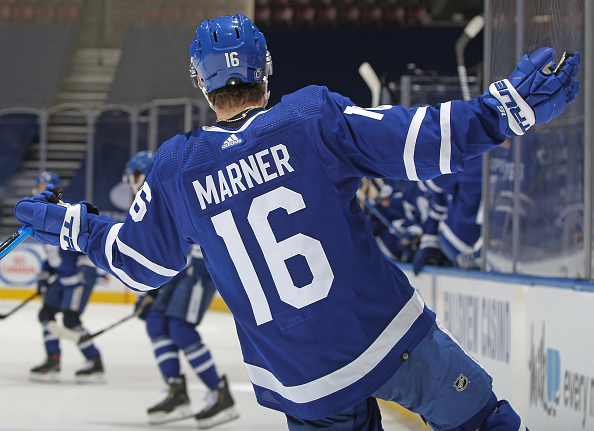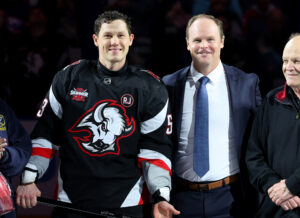Player development seems to always result in more questions than answers. How likely is it for a top pick to pan out? What makes a player a “steal”? Last Word On Hockey will be starting a new series on how to properly develop prospects from all different spots throughout the draft. This week’s piece involves top-10 picks and how they were used early in their careers.
Player Developments of Top-10 Picks
In the span of 2005 through 2015, there were 40 total selections made between fourth overall and tenth overall on forwards playing in North America. Of those 40 selections, five players were given patience in their player development. What that means is an extra year despite solid production that deemed them NHL-ready before being given a chance. Those five players were Nikolaj Ehlers, Mitch Marner, Sam Bennett, Jakub Voracek, and Derick Brassard. In this piece, we will be looking at Nikolaj Ehlers and Mitch Marner.
Player Development of Nikolaj Ehlers
Ehlers, who was drafted ninth overall by the Winnipeg Jets in 2014, was not in North America in his DY-1 season. Instead, the young man from Aalborg, Denmark played in the Swiss men’s league, the NLA, with the EHC Biel-Bienne club. Playing 11 games with the men’s team, the young Ehlers scored just one goal and two points in 11 games, good for a points-per-game rate of 0.182, which ranked last among the 40 forwards in DY-1 production.
Following that season, Ehlers would join the Halifax Mooseheads of the QMJHL for his DY season, where he scored 49 goals and 55 assists for 104 points in 63 games, an incredible rookie QMJHL season. That was good for a rate of 1.651 points per game, ranking sixth out of the 40 forwards in DY production. However, the Jets wanted Ehlers to stay in the QMJHL for another season.
In his DY+1 season, Ehlers would play 51 games with the Mooseheads, scoring 37 goals and 63 assists for 100 points in that time, a rate of 1.961 points per game. That ranked third among the 30 forwards yet to make the NHL on an expanded basis in their DY+1 season. It was after this season that the Jets would give Ehlers his much-deserved shot at the NHL.
How Was Ehlers Used?
In his rookie NHL season, Ehlers would play 72 games with the Jets. He averaged an impressive 16:06 time on ice per game that season. He scored 15 goals and 23 assists for 38 points in that impressive rookie season role. Ehlers’ advanced stats were incredibly impressive as well, finishing above replacement level in all four analytics looked at. Those analytics are even-strength offence goals above replacement (EVO), even-strength defence goals above replacement (EVD), wins above replacement (WAR) and goals above replacement (GAR). His EVO and EVD were scored at 5.3 and 0.9, respectively. While those numbers aren’t world-breaking, they are solid for a young kid. As for his WAR and GAR, he recorded an impressive 2.3 and 11.8, respectively, which are great numbers regardless of experience.
In his second NHL season, Ehlers would see a full 82 games, averaging 17:29 time on ice per game, a slight rise from his rookie year average. In that upgraded role, Ehlers would score 25 goals and 39 assists for 64 points, a solid output. His advanced analytics were all over the place compared to his rookie season, however. For example, his EVO (9.3) went up a decent amount from year one to year two. However, his EVD (-3.4) dropped below replacement level, and his WAR (1.2) and GAR (6.5) both dropped a bit from his rookie season. His numbers were still decent, however.
Ehlers Player Development Stays Consistent
Year three would see Ehlers play another full-82 game schedule. His ice time would return to his rookie year role, averaging 16:05 time on ice per game. In a smaller role, Ehlers’ production would remain similar, scoring 29 goals and 31 assists for 60 points. His analytics would improve in his third season, despite the smaller role. He remained below replacement level in EVD (-0.7), but he would improve everywhere else. The only analytic that dropped was his EVO, slightly, to 8.5. But his WAR and GAR, the two more important stats in this writer’s opinion, rose to 2.6 and 13.6, respectively.
Ehlers has played four years since the end of his third NHL season. In that span, counting what he’s done so far this season, he has recorded 80 goals and 86 assists for 166 points in 214 games played. This season, so far, the Jets have seen Ehlers produce 13 goals and 12 assists for 25 points in 34 games for them thus far.
Player Development of Mitch Marner
Marner, drafted fourth overall by the Toronto Maple Leafs in 2015, played in the OHL with the London Knights in his DY-1 season. That year, his rookie OHL season, Marner scored 13 goals and 46 assists for 59 points in 64 games. That was good for 0.922 points per game, ranking 21st out of the 40 forwards in DY-1 production. He followed that up with 44 goals and 82 assists for 126 points in just 63 games, averaging two points per game. That ranked tied for third out of the 40 forwards in DY production. However, the Leafs felt that they needed to see more.
In his DY+1 season, Marner would record 39 goals and 77 assists for 116 points in just 57 games, good for 2.035 points per game. That ranked second out of the 30 forwards for production, still without an NHL role in their DY+1 seasons. The Leafs would finally give Marner an opportunity in the NHL following that season.
How Was Marner Used?
Marner would play 77 NHL games in his rookie season, scoring 19 goals and 42 assists for 61 points in that span. He did that while averaging 16:49 time on ice per game. He would finish fifth in Calder Trophy voting that season for rookie of the year. His advanced analytics painted a better picture of Marner’s effectiveness. While his EVD was below replacement level (-2.7), every other analytic was solid. His EVO was up at 9.7 and his WAR (1.9) and GAR (10.3) were extremely impressive.
In his second NHL season, Marner would play a full-82 game season, scoring 22 goals and 47 assists for 69 points. He did that while averaging a similar ice time to last year, at 16:23 time on ice per game. His advanced analytics had a different look to the year before, despite the similar production. His EVO dropped a lot, down to 4.3. Meanwhile, his EVD blew up to 3.6, a much-improved number than the year before. That jump in EVD led to a big jump in both WAR (2.5) and GAR (13.0). But the best was yet to come.
Marner Breaks Out In Year Three
In his third NHL season, Marner would play another 82 game season, averaging a large role at 19:49 time on ice per game. That was an over three minute raise per game, on average, from the year before. In that much larger role, Marner would score 26 goals and 68 assists for 94 points, a true breakout performance for the young first-rounder. He would finish 18th in Lady Byng Trophy voting and 14th in Selke Trophy voting. His advanced analytics exploded, for the most part. Marner’s EVD returned to below replacement level, down to -1.6, but everything else soared. His EVO jumped to the double digits (13.9), his WAR was a whopping 3.5, and his GAR neared a score of 20 (18.6).
Since that third NHL season, Marner has played 154 games, scoring 53 goals and 126 assists for 179 points, all with the Leafs. Marner has been excellent from a production standpoint, landing himself as one of the “Big Four” in the 6ix. His production alongside Auston Matthews, John Tavares and William Nylander is what makes Toronto the consistent playoff competitor year in and year out. However, Marner has been hit with some ire by the passionate fans for his lack of playoff production in recent years, along with his recent inconsistency. That, paired with his massive contract of over $10 million, and it’s clear why Leafs fans have grown impatient with the former fourth overall pick. However, it is safe to say that Marner’s player development has gone as good as one can ask.
Junior league stats via Elite Prospects, NHL stats via Hockey Reference, NHL analytics via Evolving Hockey
Main Photo:






